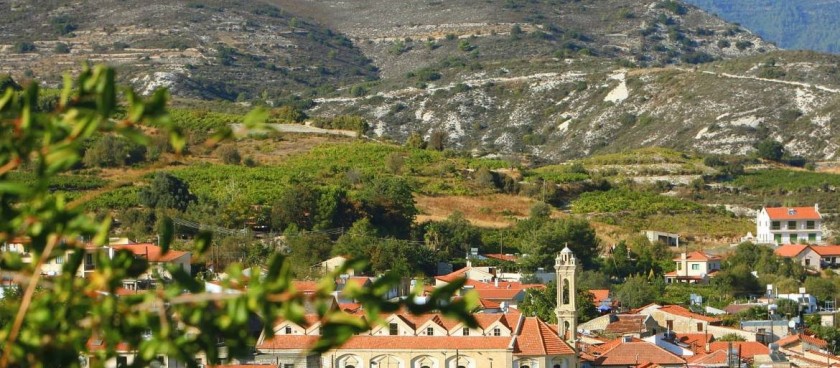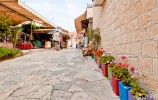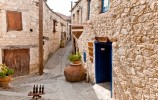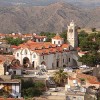-
#Authentic villages
Omodos is located about 42 kilometres north-west of the city of Limassol, in the geographical region of the wine-making villages. It is built near the west bank of the Cha-potami river at an average altitude of 810 meters. The village is surrounded by tall mountaintops, the tallest of which are "Afames" (1153 m.) and "Kremmos of Laona" (Laona's Cliff, 1092 m.).
The village receives an annual average rainfall of about 760 millimetres; vines and various fruit-trees (apple, plum, pear, peach, and apricot trees) are cultivated in the region. There also are uncultivated areas that are taken over by varied natural vegetation. A small part of the village -in its north part -is taken up by the state forest of Pafos.
Regarding transportation, Omodos is connected with the village of Mandria (4 km.) in the north-east and the villages Vasa Koilaniou (3 km.) and Malia (5.5 Km.) in the south-west.
The village was quite probably created at the end of the Byzantine era or the beginnings of the Frank Domination era, after the Pano and Kato (Upper and Lower) Koupetra settlements, found in the east bank of the Cha-potami river, were dissolved. According to tradition, Isaac Comnenos -who was the despot of Cyprus (1185-1191) -found refuge in Koupetra after his defeat by the English King Richard Coeur-de-Lion in Kolossi until Richard summoned him to Limassol for talks and a truce. This means that Koupetra existed in 1191 and dissolved later.
After the break-up of the Koupetra settlements a new settlement was created around the original Holy Cross Monastery, taking the name Omodos.
In any case, the village did exist during the Frank Domination era. De Masse Latri mentions it as a feud. The mediaeval annalist Leondios Machairas reports that Omodos had been granted to the nobleman Jean de Brie by the king of Cyprus, Jacob I, on the occasion of his election in 1832. The village is found marked in old maps as Homodos, Homocios, and Omodos.
For the Greek name of the village the predominant interpretations are the following three: Coming from the Cypriot word "modos", which means, "taking your time", with tact, carefully. The inhabitants of Koupetra, after observing a light at the opposite mountain every night, went to see what was going on and found that the light was coming out of a thick and unapproachable, prickly bush; in order to get through it they had to cut it down, telling one another "me to modo sou" (meaning "take your time, act carefully"), until they finally entered a cave with a wooden cross and a candle inside. Many streets that lead to the surrounding villages start from the village. Out of the adverb "omou" (with) and the word "odos" (street), Omodos was formed. It is reported in Frank documents that the feudal lord Homodeus lived in the region and it is very probable that the village was named after him.
Since ancient times Omodos is renowned for its superb grapes and tasty wines. According to tradition, the -of excellent quality and sweet smelling -wine Afames, which took its name from the mountain that bares the same name and is located east of the village, was the cause for the island being conquered by the inebriate Sultan Selem II so that he could have this famous wine as his own.
The known mediaeval winepress, found at a small distance from the Holy Cross Monastery, is evidence to the fact that production of traditional wine took place in Omodos since ancient times. The inhabitants of Omodos, apart from growing vines and producing excellent wine and "zivania" (traditional alcoholic beverage), also handle the making of "soutzoukos" (must-stick with almonds), "palouze" (must jelly), "kkiofterka" (dried must jelly in rhomboid pieces), and "koulourka" (rusks). The "arkatena koulourka" (crunchy rusks with yeast) of Omodos are also well known and sought after throughout Cyprus. Also, genuine and of excellent taste sweets are made out of local fruits. Home handicraft flourishes in Omodos. The village's women, apart from the plentiful and hard work that they offer next to their husbands for the cultivation of the earth, are also occupied with handmade embroideries, making wonderful brocades, tablecloths, threaded quilts, and narrow-knit and Chantilly laces.
Omodos, built at the slope of the mountain, between a verdant carpet of vines, surrounded by mountains that appear as though they were placed in a masterly layout, is one of the most picturesque villages of Cyprus. The large plaza of the village, unique in its graphic quality and size, in front of the majestic monastery of the Holy Cross, the mediaeval Winepress, the narrow alleys, and the stone-made houses all "drowned" in green lend a special beauty and charm to the village. Moreover, the village's houses themselves present some interest as far as folkloric architecture is concerned, with the tiled roofs or terraces, the picturesque upper storeys, the paved and flowery yards with jars inside, the wooden doors and the variously decorated gateways, and the balconies and elongated rooms being the main elements. Folkloric art is also preserved in a traditional manner inside the houses where one can observe the old, tall bed with the in-wrought mosquito net, the chiselled couch, the chairs with straw-fibre, the walls decorated with frames made out of silkworm cocoons, the fire-stove and chimney with its copper-made pots, the "tsestos" (wicker-made hamper) and the "tatsia" (very fine sieve). In addition, the large, red jars used for the storage of wine are found in the house's stockroom, which is -above everything else -a workroom for the processing of grapes. The old plough, the wineskin, the grapes' grinder, the hampers, and the caldron for the "zivania" are also still preserved.



